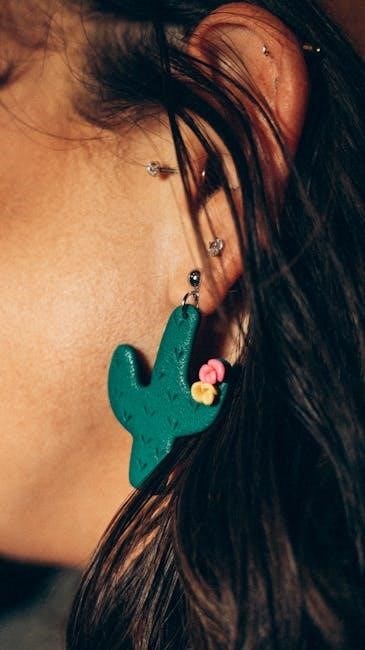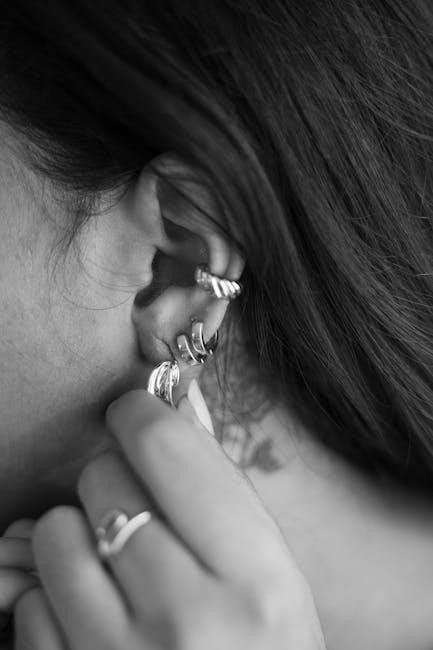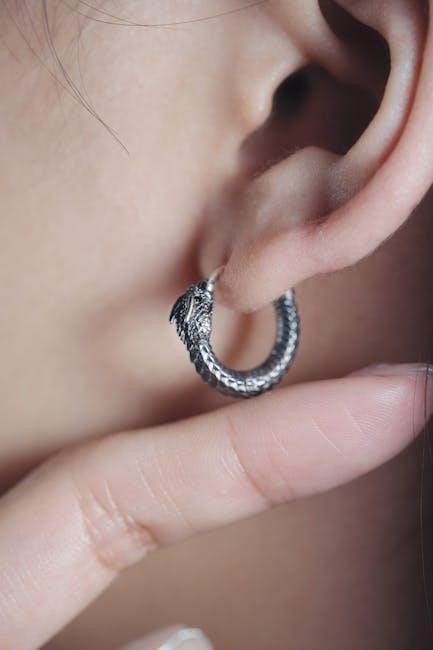Ear piercings are a popular form of self-expression‚ but proper care is essential․ This guide provides aftercare instructions for optimal healing and helps avoid complications such as infections․ Choosing a qualified piercer is the first key step!
Choosing a Piercer and Studio
Selecting a reputable piercer and licensed studio is crucial․ Look for experience and proper sterilization practices․ A clean environment and skilled professional will minimize risks and ensure a safer piercing experience․
Licensing and Experience
When choosing a piercer‚ verify their licensing and experience․ A licensed piercer adheres to health and safety standards․ Experienced piercers possess the knowledge to perform piercings safely and effectively․ Look for a portfolio of their work and read reviews․ Don’t hesitate to ask about their training and sterilization protocols․ A skilled and licensed piercer will prioritize your safety and ensure a positive piercing experience․ They can also provide valuable aftercare advice tailored to your specific piercing type for optimal healing․

Ear Piercing Aftercare: Initial Steps
Proper aftercare is crucial for a successful healing process․ Diligent care helps prevent infections and ensures your piercing heals correctly․ Start with clean hands and follow your piercer’s instructions carefully․
Importance of Aftercare
Aftercare is paramount to prevent infections and ensure your new ear piercing heals correctly and quickly․ Neglecting aftercare can lead to complications‚ such as prolonged healing times‚ infections‚ or even the piercing closing up entirely․ Proper cleaning and maintenance also contribute to the overall appearance and longevity of your piercing․ Consistent aftercare ensures a comfortable and aesthetically pleasing outcome‚ allowing you to enjoy your new piercing for years to come‚ minimizing risks and maximizing satisfaction with your body modification․
Washing Hands Before Touching
Prior to touching or cleaning your new ear piercing‚ washing your hands thoroughly is essential․ Our hands accumulate bacteria throughout the day․ Introducing this bacteria to your fresh piercing can significantly increase the risk of infection․ Use soap and warm water‚ scrubbing for at least 20 seconds‚ ensuring you clean between your fingers and under your nails․ This simple act of hygiene minimizes the chances of contamination and promotes a healthy healing process for your new ear piercing‚ ensuring a safer and more comfortable experience․
Cleaning Your New Piercing
Proper cleaning is crucial for a new ear piercing․ Regular cleaning helps prevent infection and promotes faster healing․ Follow specific instructions given by your piercer for optimal results and care․
Cleansing Solutions: What to Use
Choosing the right cleansing solution is paramount for your new ear piercing’s healing․ Opt for sterile saline solution‚ readily available at most drugstores․ Avoid harsh chemicals like alcohol‚ hydrogen peroxide‚ or strong soaps‚ as they can irritate the piercing and delay healing․ A mild‚ fragrance-free soap can be considered‚ but ensure thorough rinsing afterward․ Always follow your piercer’s specific recommendations for the best cleansing solution and practices tailored to your piercing type․
Cleaning Frequency
Consistency is key when it comes to cleaning a new ear piercing․ Generally‚ cleaning the piercing two to three times daily is recommended during the initial healing period․ Over-cleaning can irritate the piercing‚ while under-cleaning can lead to infection․ Adjust the frequency based on your piercer’s advice and your body’s response․ Be mindful of activities that may expose the piercing to dirt or bacteria‚ and clean it promptly afterward to maintain a healthy healing environment․
How to Clean the Piercing
To properly clean your new ear piercing‚ begin by washing your hands thoroughly․ Saturate a clean cotton swab or pad with your chosen cleansing solution․ Gently cleanse the skin around the piercing‚ front and back‚ removing any crust or debris․ Rotate the jewelry carefully to ensure the solution reaches all areas of the piercing․ Pat the area dry with a clean paper towel or allow it to air dry․ Avoid using cloth towels‚ which can harbor bacteria․
What to Expect During Healing
Healing times vary․ Initial swelling‚ redness‚ and tenderness are normal․ Adhering to a consistent aftercare routine is essential for minimizing discomfort and promoting faster healing‚ preventing potential complications during the process․
Normal Swelling and Discomfort
Expect some swelling‚ redness‚ and tenderness around a new ear piercing; This is a normal inflammatory response as your body begins the healing process․ The area may feel warm to the touch and appear slightly raised․ Discomfort is usually mild and manageable with over-the-counter pain relievers․ Avoid touching the piercing unnecessarily‚ as this can exacerbate swelling and increase the risk of infection․ Gentle cleaning‚ as instructed by your piercer‚ will help alleviate discomfort and promote healing․ Remember to monitor for signs of excessive pain or pus‚ which could indicate an infection․
Healing Times for Different Piercings
Healing times vary significantly depending on the ear piercing location․ Earlobe piercings typically heal within 6-8 weeks‚ while cartilage piercings‚ such as helix or daith piercings‚ can take significantly longer‚ ranging from 4 months to a year․ Thicker cartilage areas generally require more time to heal․ Individual anatomy and adherence to aftercare instructions also play a crucial role․ Consistent cleaning and avoiding irritation will promote faster healing․ Patience is key‚ as premature removal of jewelry can lead to closure or complications․ Consult your piercer for any concerns regarding the healing process․
Things to Avoid During Healing
Proper aftercare is essential for healing․ Avoid touching the piercing with dirty hands‚ swimming‚ and tanning․ Also‚ refrain from alcohol and smoking‚ as these can hinder the healing process‚ leading to potential complications․
Touching the Piercing with Dirty Hands
One of the most critical things to avoid during the healing process of a new ear piercing is touching the area with unwashed hands․ Our hands come into contact with countless surfaces throughout the day‚ harboring bacteria and germs․ Introducing these to a fresh piercing significantly increases the risk of infection․ Always ensure your hands are thoroughly washed with soap and water before any contact with your new piercing to promote a healthy healing environment and prevent complications․
Swimming and Tanning
During the initial healing phase of a new ear piercing‚ it’s crucial to avoid swimming in pools‚ hot tubs‚ lakes‚ rivers‚ or the ocean due to the bacteria and chemicals present‚ which can cause infection․ Tanning‚ whether natural sunlight or tanning beds‚ should also be avoided․ Sun exposure can irritate the new piercing‚ potentially leading to inflammation and delayed healing․ Protecting your piercing from these elements is essential for a smooth recovery and reduces the risk of complications․
Alcohol and Smoking
Consuming alcohol or smoking cigarettes can negatively impact the healing process of a new ear piercing․ Alcohol can thin the blood‚ potentially leading to increased bleeding and swelling around the piercing site․ Smoking‚ on the other hand‚ restricts blood flow to the area‚ hindering the body’s ability to heal effectively; Furthermore‚ both alcohol and smoking can compromise the immune system‚ making the piercing more susceptible to infection․ It’s best to avoid these substances during healing to promote faster recovery․

Recognizing Signs of Infection
Being able to identify an infected piercing is crucial․ Look out for excessive redness‚ swelling‚ persistent pain‚ unusual discharge (especially pus)‚ and a burning sensation․ If these appear‚ seek prompt medical advice․
Symptoms of Infection
An infected ear piercing can manifest through several noticeable symptoms․ Key indicators include increased redness around the piercing site‚ persistent and throbbing pain‚ unusual discharge that may be yellow or green (pus)‚ and excessive swelling beyond the initial few days․ You might also experience a burning sensation or tenderness to the touch․ A fever could also be a sign that an infection has taken hold․ Monitor your piercing closely and be aware of changes․
When to Seek Medical Advice
If you observe signs of a worsening infection in your ear piercing‚ seeking prompt medical advice is crucial․ If symptoms persist or worsen despite diligent aftercare‚ consult a doctor․ Specifically‚ seek medical attention if you develop a fever‚ experience severe pain‚ notice spreading redness or swelling‚ or observe thick‚ discolored discharge․ These could indicate a more serious infection requiring professional treatment‚ such as antibiotics․ Don’t delay seeking help if you’re concerned․

Jewelry Considerations
Maintaining jewelry during healing is crucial to keep the piercing open․ A downsizing appointment is recommended 4-6 weeks post-piercing․ This helps prevent irritation and ensures a comfortable fit as the swelling reduces․
Keeping Jewelry in During Healing
It is important to leave your initial piercing jewelry in place throughout the entire healing period․ Removing it prematurely can lead to the piercing closing up‚ especially in the early stages․ Even for cleaning‚ the jewelry should remain in the ear․ Consistent presence of the jewelry helps maintain the channel and promotes proper healing from the inside out‚ preventing complications and ensuring a successful piercing journey‚ by letting the area heal correctly․
Downsizing Appointment
A downsizing appointment‚ typically scheduled around 4-6 weeks after the initial piercing‚ is crucial for long-term comfort․ The initial jewelry often accommodates swelling‚ but once the swelling subsides‚ a shorter post can prevent irritation․ Downsizing minimizes the risk of the jewelry catching on clothing or moving excessively‚ which can lead to friction bumps or prolonged healing times․ This step ensures the piercing settles comfortably and promotes a smoother‚ hassle-free healing process‚ helping ensure a lasting and beautiful piercing result․

Additional Tips and Advice
Beyond the core aftercare steps‚ consider these additional tips for a smoother piercing experience․ Avoid swimming in chlorinated pools or the sea for at least four weeks post-piercing to minimize infection risk․ Skip sunbeds and tanning for the first two weeks‚ as UV exposure can irritate the new piercing․ Refrain from using harsh soaps or beauty products directly on the pierced area․ Patience is key; healing times vary‚ so trust the process․ Regular cleaning and gentle care will contribute to a successful and beautiful piercing outcome․
